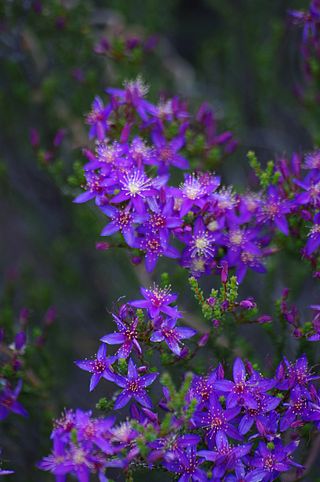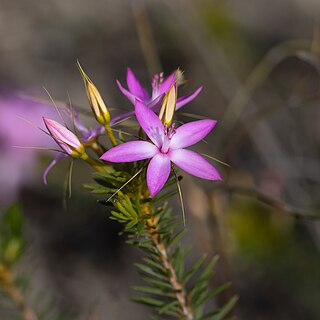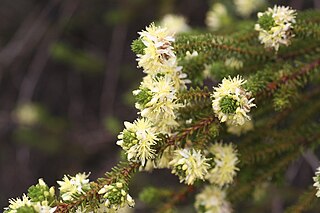
Calytrix depressa is a species of flowering plant in the myrtle family Myrtaceae and is endemic to the south-west of Western Australia. It is a glabrous shrub with linear to lance-shaped leaves and mauve to violet or yellow flowers with 35 to 75 stamens in several rows.

Calytrix leschenaultii is a species of flowering plant in the myrtle family Myrtaceae and is endemic to the Southwest Australia of Western Australia. It is a mostly glabrous shrub with egg-shaped, elliptic, lance-shaped or linear leaves and purple, mauve, violet or pink flowers with a white or yellow base, and 6 to 40 white or yellowish stamens.

Calytrix achaeta, commonly known as the white-flowered turkey bush, kerosene wood or fringe-myrtle, is a species of flowering plant in the myrtle family Myrtaceae and is endemic to north-western Australia. It is a shrub or tree with hairy branchlets, egg-shaped, linear or lance-shaped leaves, and white to cream-coloured flowers with 12 to 18 stamens in a single row.

Calytrix asperula, commonly known as brush starflower, is a species of flowering plant in the myrtle family Myrtaceae and is endemic to the south of Western Australia. It is a mostly glabrous shrub with linear to narrowly elliptic leaves and cream-coloured to yellow flowers with 40 to 60 yellow stamens in several rows.
Calytrix birdii is a species of flowering plant in the myrtle family Myrtaceae and is endemic to inland areas of Western Australia. It is a shrub with egg-shaped to more or less round leaves and clusters of purple flowers with 45 to 55 reddish-purple stamens in several rows.

Calytrix brevifolia is a species of flowering plant in the myrtle family Myrtaceae and is endemic to the west of Western Australia. It is a glabrous shrub with egg-shaped, linear, elliptic or more or less round leaves and clusters of pink to magenta flowers with about 40 to 90 yellow stamens in 4 rows.

Calytrix creswellii is a species of flowering plant in the myrtle family Myrtaceae and is endemic to inland areas of Western Australia. It is a spreading, glabrous shrub usually with egg-shaped leaves with the narrower end towards the base, and clusters of white flowers with about 40 to 55 white or yellow stamens in several rows.

Calytrix decandra, commonly known as pink starflower, is a species of flowering plant in the myrtle family Myrtaceae and is endemic to the south of Western Australia. It is a semi-prostrate, glabrous shrub with linear to narrowly elliptic leaves and pink, mauve or magenta flowers with usually 10 stamens in a single row.

Calytrix desolata is a species of flowering plant in the myrtle family Myrtaceae and is endemic to the western regions of Western Australia. It is a glabrous shrub with linear oblong or lance-shaped leaves with the narrower end towards the base, and pink to purple flowers with about 30 to 60 stamens in several rows.

Calytrix drummondii is a species of flowering plant in the myrtle family Myrtaceae and is endemic to the Geraldton Sandplains bioregion of Western Australia. It is a glabrous shrub with linear leaves, and yellow flowers with about 55 to 85 yellow stamens in several rows.

Calytrix duplistipulata is a species of flowering plant in the myrtle family Myrtaceae and is endemic to inland areas of Western Australia. It is a glabrous shrub with elliptic to egg-shaped or oblong leaves, and pink to purple flowers with about 9 to 16 stamens in a single row.
Calytrix erosipetala is a species of flowering plant in the myrtle family Myrtaceae and is endemic to inland areas of Western Australia. It is a glabrous shrub with spreading lance-shaped to egg-shaped or linear leaves, and white to pink flowers with about 18 to 24 stamens in a single row.
Calytrix formosa is a species of flowering plant in the myrtle family Myrtaceae and is endemic to the west of Western Australia. It is a glabrous shrub with erect, elliptic, broadly elliptic or oblong leaves, and pink flowers with about 90 to 105 stamens in multiple rows.
Calytrix gypsophila, commonly known as gypsum fringle-myrtle, is a species of flowering plant in the myrtle family Myrtaceae and is endemic to southern continental Australia. It is a glabrous shrub with oblong, linear or lance-shaped leaves with the narrower end towards the base, and white flowers with 25 to 40 stamens in a single row.
Calytrix harvestiana is a species of flowering plant in the myrtle family Myrtaceae and is endemic to the west of Western Australia. It is a glabrous shrub with linear, elliptic or egg-shaped leaves and purplish mauve to purple or violet flowers with about 60 to 70 pale yellow stamens in multiple rows.

Calytrix sapphirina is a species of plant in the myrtle family Myrtaceae that is endemic to Western Australia.

Calytrix glaberrima, commonly known as smooth fringe-myrtle, is a species of flowering plant in the myrtle family Myrtaceae and is endemic to the south of South Australia. It is a woody, glabrous shrub with elliptic, linear or egg-shaped leaves and clusters of white to pink flowers with 20 to 30 white stamens in a single row.

Veronica densifolia, is a flowering plant in the family Plantaginaceae. It is a low-growing, spreading plant with pink, white or purple flowers and grows in New South Wales.

Calytrix involucrata, commonly known as cup fringe-myrtle, is a species of flowering plant in the myrtle family Myrtaceae and is endemic to the south of South Australia. It is a glabrous shrub with linear to elliptic leaves and clusters of white flowers sometimes tinged with pink, with 17 to 25 white stamens in a single row.

Calytrix leptophylla is a species of flowering plant in the myrtle family Myrtaceae and is endemic to Queensland. It is a glabrous shrub with linear leaves, and pink to light purple flowers with a white base, and about 35 to 40 white to yellow stamens in several rows.
















